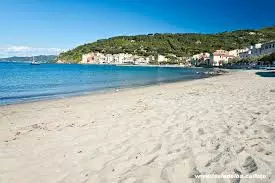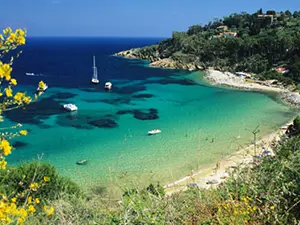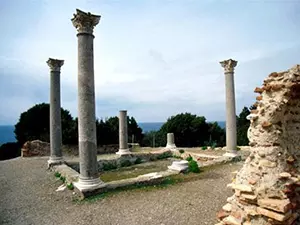Tuscan islands

1 • Capraia
The port of the island of Capraia is a tourist marina that can accommodate up to 99 boats, during the summer it is advisable to book. Bars, restaurants and some shops, make it the center of the summer evening and night "struscio", animated by dozens of crews and tourists in general. The coasts of the island, gently sloping towards the sea, offer the possibility of bathing even in shallow waters, sometimes with a sandy and very clear bottom. A single sandy beach, Cala della Mortola, can be reached only by boat; the remaining coves are all in rock or rock. Don't miss a stop at Cala Rossa.
1 • Capraia

The port of the island of Capraia is a tourist marina that can accommodate up to 99 boats, during the summer it is advisable to book. Bars, restaurants and some shops, make it the center of the summer evening and night "struscio", animated by dozens of crews and tourists in general. The coasts of the island, gently sloping towards the sea, offer the possibility of bathing even in shallow waters, sometimes with a sandy and very clear bottom. A single sandy beach, Cala della Mortola, can be reached only by boat; the remaining coves are all in rock or rock. Don't miss a stop at Cala Rossa.

2 • Marciana Marina
Leaving Capraia head towards the island of Elba; you will arrive in Marciano Marina, where there is one of the safest and most equipped marinas on the island. Beautiful walk along the seafront that from the Cotone (ancient natural shelter for boats) leads to the Saracen Tower built in the XII century. from the Pisans for the sighting of pirates. The town is charming with its historic streets and squares, many shops and restaurants are present. Its beaches: Fenicia is located behind the Saracen Tower and Crocetta at about 600 meters. from the village, both are gravel.
2 • Marciana Marina

Leaving Capraia head towards the island of Elba; you will arrive in Marciano Marina, where there is one of the safest and most equipped marinas on the island. Beautiful walk along the seafront that from the Cotone (ancient natural shelter for boats) leads to the Saracen Tower built in the XII century. from the Pisans for the sighting of pirates. The town is charming with its historic streets and squares, many shops and restaurants are present. Its beaches: Fenicia is located behind the Saracen Tower and Crocetta at about 600 meters. from the village, both are gravel.

3 • Marina di Campo
Once in Marina di Campo you will find a village on the right side of the beach. In the center is the ancient fishing village, the small port, the colorful and picturesque houses, all dominated by the Pisan tower, formerly used for sighting. The town has a nice walk along the seafront and is famous as an evening meeting. The beach of Marina di Campo is the largest on the island, it begins in the town and stretches for 1500 m until it reaches loc. la Foce. Although there is a quay in Marina di Campo, mooring is not permitted for transit, so you will have to stay at anchor.
3 • Marina di Campo

Once in Marina di Campo you will find a village on the right side of the beach. In the center is the ancient fishing village, the small port, the colorful and picturesque houses, all dominated by the Pisan tower, formerly used for sighting. The town has a nice walk along the seafront and is famous as an evening meeting. The beach of Marina di Campo is the largest on the island, it begins in the town and stretches for 1500 m until it reaches loc. la Foce. Although there is a quay in Marina di Campo, mooring is not permitted for transit, so you will have to stay at anchor.

4 • Isola del Giglio
The island's port is located on the east coast of the island. The built-up area, originally made up of fishermen's houses, develops around it and is characterized by the promenade and streets that open into the characteristic Piazza della Dogana, considered the island's living room. Among the monuments of historical interest, the Torre del Saraceno, of medieval origins, and the Church of the Madonna del Giglio stand out.
Giglio Castello is located in the central, highest and internal part of the island, to see the imposing Rocca aldobrandesca and the well-preserved walls. Among the beaches not to be missed are the Campese beach, located within a bay on the west coast about 15 minutes from the port, it is the largest beach on the island and its sand is dark red. It is also known for its beautiful sunsets.
Another beach is Cala delle Cannelle located on the east coast south of the port. The sand is clear and the sea is ideal for those who practice snorkeling. Finally we point out the Arenella beach, one of the most beautiful for its sceneries that alternate light sand and rocks.
4 • Isola del Giglio

The island's port is located on the east coast of the island. The built-up area, originally made up of fishermen's houses, develops around it and is characterized by the promenade and streets that open into the characteristic Piazza della Dogana, considered the island's living room. Among the monuments of historical interest, the Torre del Saraceno, of medieval origins, and the Church of the Madonna del Giglio stand out.
Giglio Castello is located in the central, highest and internal part of the island, to see the imposing Rocca aldobrandesca and the well-preserved walls. Among the beaches not to be missed are the Campese beach, located within a bay on the west coast about 15 minutes from the port, it is the largest beach on the island and its sand is dark red. It is also known for its beautiful sunsets.
Another beach is Cala delle Cannelle located on the east coast south of the port. The sand is clear and the sea is ideal for those who practice snorkeling. Finally we point out the Arenella beach, one of the most beautiful for its sceneries that alternate light sand and rocks.

5 • Isola di Giannutri
Giannutri is the southernmost island of the Tuscan Archipelago and is located about 8 miles south-east of the Island of Giglio, of which it is part, and about 6 miles south of the Argentario. It is characterized by a jagged and rocky coast, interrupted by suggestive coves and numerous caves. On the island there are two landings: Cala Spalmatoio, to the south-east and Cala Maestra, to the north-west.
5 • Isola di Giannutri

Giannutri is the southernmost island of the Tuscan Archipelago and is located about 8 miles south-east of the Island of Giglio, of which it is part, and about 6 miles south of the Argentario. It is characterized by a jagged and rocky coast, interrupted by suggestive coves and numerous caves. On the island there are two landings: Cala Spalmatoio, to the south-east and Cala Maestra, to the north-west.
.webp)
6 • Porto Azzurro
Porto Azzurro, located in the deep cove of the Gulf of Mola, has a good tourist port, a beautiful square on the sea (evening meeting place) and picturesque alleys where there are shops, bars, restaurants and in the evening, craft stalls. In the village there is a small beach, the others are nearby.
6 • Porto Azzurro
.webp)
Porto Azzurro, located in the deep cove of the Gulf of Mola, has a good tourist port, a beautiful square on the sea (evening meeting place) and picturesque alleys where there are shops, bars, restaurants and in the evening, craft stalls. In the village there is a small beach, the others are nearby.
.webp)
7 • Golfo di Baratti
Returning towards Castiglioncello a must is the beautiful Gulf of Baratti. The cove is characterized by a sandy beach, more extensive in the central-northern part of the gulf, which tends to be considerably reduced towards the southern end of the port of Baratti. The seabed is low, while the beach is characterized both by golden and amber colors, and by the presence of iron slag, remnants of the processing of this metal during the Etruscan period. The area is dotted with archaeological remains from the Etruscan era.
7 • Golfo di Baratti
.webp)
Returning towards Castiglioncello a must is the beautiful Gulf of Baratti. The cove is characterized by a sandy beach, more extensive in the central-northern part of the gulf, which tends to be considerably reduced towards the southern end of the port of Baratti. The seabed is low, while the beach is characterized both by golden and amber colors, and by the presence of iron slag, remnants of the processing of this metal during the Etruscan period. The area is dotted with archaeological remains from the Etruscan era.
